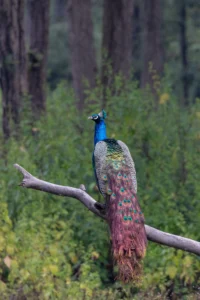The peacock, scientifically known as Pavo cristatus, is not just a bird—it’s a living spectacle of nature’s beauty and grace. Revered for its striking appearance, rich symbolism, and role in various cultures and ecosystems, the peacock has fascinated people for centuries. Native to the Indian subcontinent, the peacock has become a universal symbol of beauty, pride, and regality, captivating everyone who comes across it.
Physical Appearance: Nature’s Masterpiece
The male peacock, or peafowl, is renowned for its spectacular plumage. Its tail feathers, which can span over five feet in length, feature a breathtaking array of iridescent blues, greens, and golds. These feathers are adorned with eye-catching “eyes,” circular patterns that shimmer in the light, giving the bird an almost mythical quality.
The female peacock, called a peahen, is far more muted in color, with a brownish and greyish plumage. This difference in appearance is a result of sexual dimorphism, where the male exhibits more vibrant colors to attract females. Despite her subtler hues, the peahen plays a crucial role in the species’ survival, as she selects mates based on the quality and brilliance of the male’s display.
The vibrant tail feathers of the peacock’s, known as a train, are used in courtship rituals. During mating season, the male fans out his train and shakes it to display his beauty. The peacock’s ability to keep these long feathers intact and in pristine condition is a sign of health, which influences the peahen’s choice of mate.
Cultural Significance and Symbolism
Throughout history, the peacock’s has been a symbol of various qualities across different cultures. Its elaborate plumage has made it a symbol of royalty, immortality, beauty, and grace in many civilizations.
- In Hinduism, the peacock is associated with the goddess Lakshmi, the deity of wealth and prosperity. The bird’s vibrant colors represent the opulence and beauty of the goddess herself. Additionally, the god Kartikeya, the god of war, is often depicted riding a peacock, further associating the bird with power and protection.
- In Christianity, the peacock’s are considered a symbol of resurrection and immortality, largely due to the belief that its flesh does not decay after death. Early Christian art often depicted the bird as a symbol of eternal life, linking it to spiritual rebirth.
- In ancient Greek and Roman mythology, the peacock was the sacred bird of Hera, the queen of the gods. According to the myth, Hera placed the eyes of her favorite creature, the Argus, into the peacock’s tail after his death, giving the bird its distinctive eye-like spots.
- In China, the peacock’s are regarded as a symbol of beauty and dignity. The bird’s appearance is often associated with grace and elegance in traditional Chinese art and poetry.
In addition to its cultural meanings, the peacock has become a global symbol of extravagance and beauty in modern contexts, often appearing in design, fashion, and even branding, where it symbolizes high status and opulence.
Behavior and Habitat
The peacock’s are primarily a terrestrial bird, spending most of its time on the ground in search of food. However, it is an excellent flier and can take to the air when necessary, though it usually prefers walking or running. They are omnivorous and feed on a wide variety of foods, including seeds, fruits, insects, and small reptiles. 
Peafowls are found in forests, grasslands, and savannahs in the wild, primarily in the Indian subcontinent, Sri Lanka, and parts of Southeast Asia. They thrive in habitats where dense underbrush offers both food and protection. However, due to their popularity as ornamental birds, peafowls have also been introduced to regions like Africa, Australia, and parts of Europe, where they adapt well to different environments.
Peafowl are social birds, often found in small groups, especially outside the breeding season. They communicate using a variety of calls, with the males producing loud, resonant calls during the mating season to attract females and assert their dominance over other males.
Conservation Status
The peacock is classified as Least Concern by the International Union for Conservation of Nature (IUCN), due to its wide distribution and stable population. However, habitat loss, hunting, and the illegal pet trade have threatened local populations, especially in areas where the birds are not well protected.
In many countries, the peacock is a protected species, with strict regulations against hunting and capturing. Conservation efforts focus on preserving natural habitats and ensuring that local communities respect the bird’s cultural significance and ecological role.
Fun Facts about the Peacock
- Color Change: The peacock’s feathers are not actually pigmented. Instead, the colors are produced through microscopic structures that refract light, creating the iridescent effect.
- Tail Feathers Aren’t Always Displayed: A peacock only displays his impressive tail feathers during the breeding season, when he’s trying to impress a mate. Otherwise, the feathers are folded up and hidden.
- A Large Range of Calls: Peafowls have a diverse range of vocalizations, from a harsh, metallic call to softer, more melodic sounds, which help them communicate with others in their group.
- Long-Lived Creatures: In the wild, peafowls can live up to 15 years, and in captivity, they can live as long as 25 years.
Conclusion
The peacock is more than just a symbol of beauty; it represents cultural heritage, ecological importance, and an enduring link between nature and human civilization. From its breathtaking appearance to its cultural significance, the peacock continues to captivate the imagination of people around the world. Whether standing proudly in a lush forest or adorning the walls of ancient temples, the peacock’s remains an emblem of nature’s splendor, inspiring awe and admiration wherever it goes.
Learn More About Other Pets: penguins
NAME: ABD-UR-RAFAY